Integrated into the Dutch culture as I am, I make extensive use of my bike. Whenever I mention it in vlogs or videos, my viewers leave the strangest comments. Think along the lines of: “that looks fun!”, “what bike is best for you?” and “why don’t you wear a helmet?”
After thinking on it for a while, I realised those questions and comments aren’t weird at all. In fact, they make complete sense in any other context than ours here. What’s actually weird is the way the Dutch use their bikes.
So I decided to go out into the streets of Utrecht with my camera, and document the strangest-yet-completely-normal things there are, concerning bikes and cycling in the Netherlands.
– Please note: this is a re-post of a piece I wrote back in the summer of 2014, when I lived in Utrecht. I really enjoy this one and thought it deserved another spotlight. That’s why nobody is socially distanced or dressed weather-appropriately in the photos! –
Firstly, you should know that the Dutch mostly use their bikes not for leisure or sport, but as transportation. The Netherlands are a tiny country with small cities, in which driving a car often just isn’t practical. Riding a bike is usually the fastest and easiest way to get to your destination. Many people don’t consider cycling an enjoyable activity, it’s just something that needs to be done. So, with that in mind, you’re ready to be immersed into full Dutch bike bizarreness.
Let’s start by going over ways we like to transport things on bikes (yes, we do carry things around).
The Bakfiets
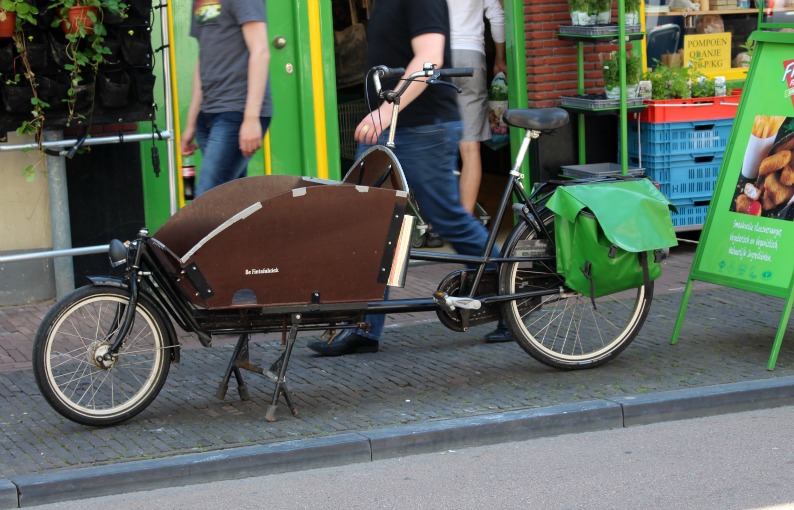
This, ladies and gentlemen, is a bakfiets: a “bin bike”. It’s a bicycle with a big container in the front, used for transporting items such as groceries, dogs, or…
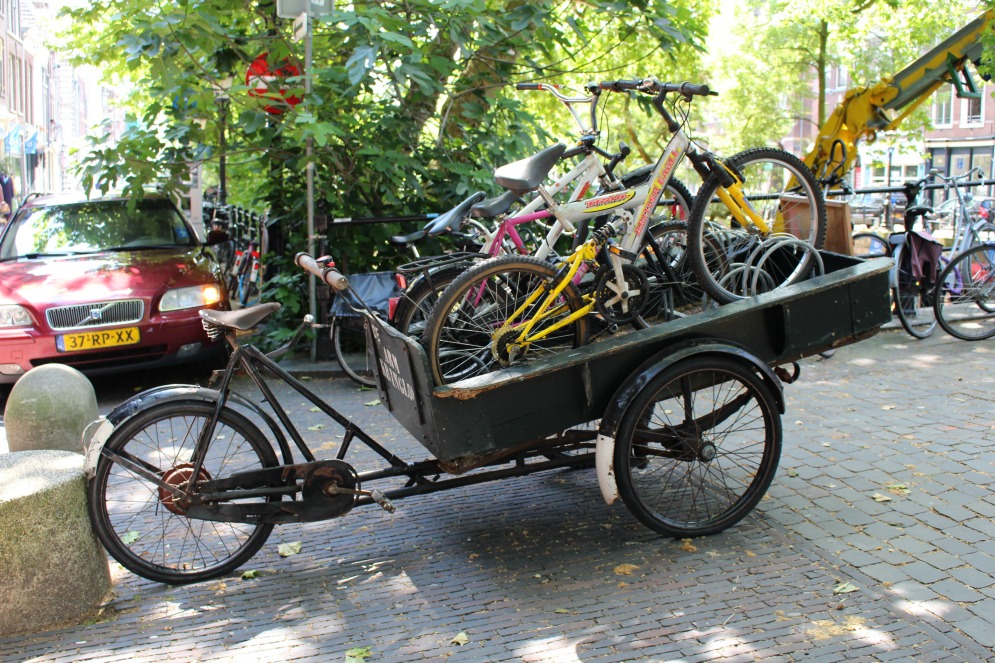
Other bicycles. Why not. Cycleception.
But more commonly, it’s used for the transportation of:

Children. I kid you not (pun intended). The bakfiets is convenient for transporting larger amounts of children- I’ve seen up to six little ones being driven around in these and it’s quite common for kindergartens to use them on outings.
Speaking of transporting children, there are other ways of doing that as well.
The Bike Seat
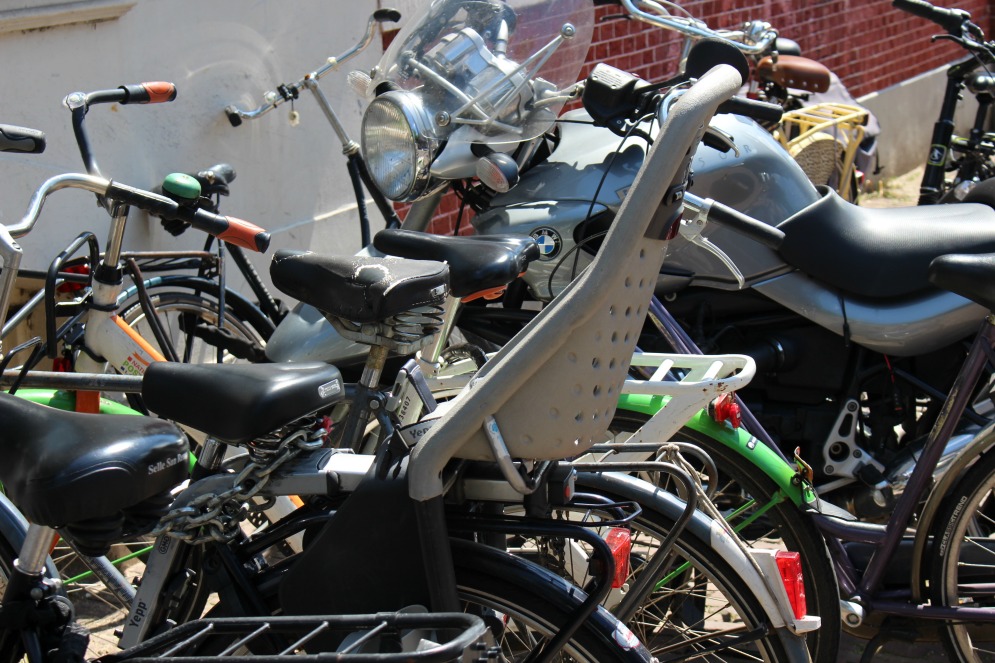
This is a typical bike seat for young children. It’s considered safe because the child is strapped into the seat, it can’t jump off, and its feet can’t get into the spokes (in theory, at least).
Some moms take the bike seat to the next level:
The Multiples
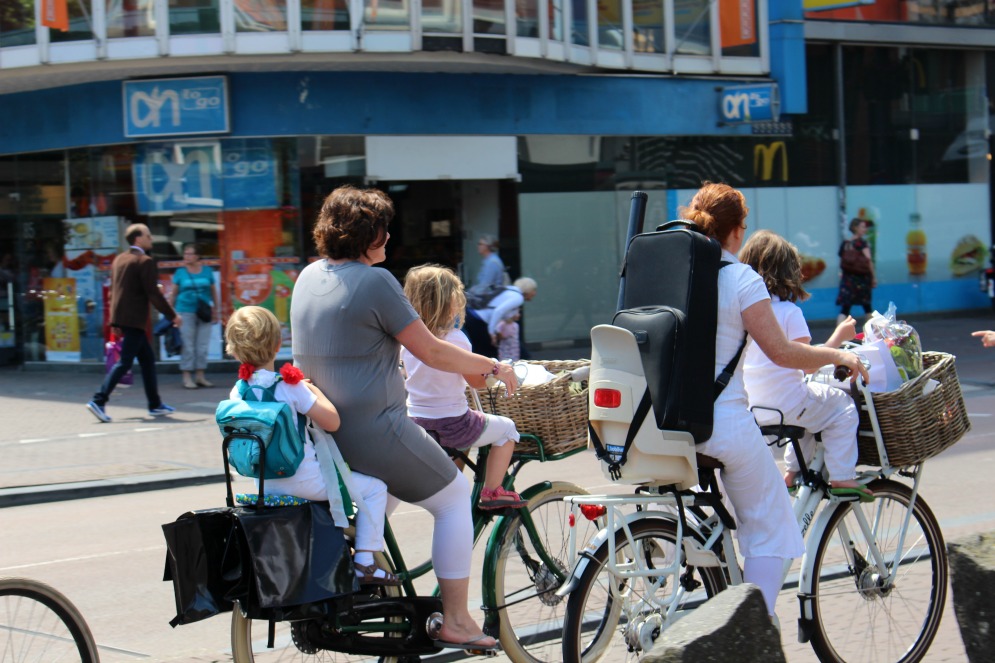
Up to three children can fit onto one bike, all in their respective bikeseats. Plus, for the over-achievers among us, the basket in the front is a perfect spot for a little canine friend. More on that later.
Let’s move on to other carry-on options.
The Bike Bags
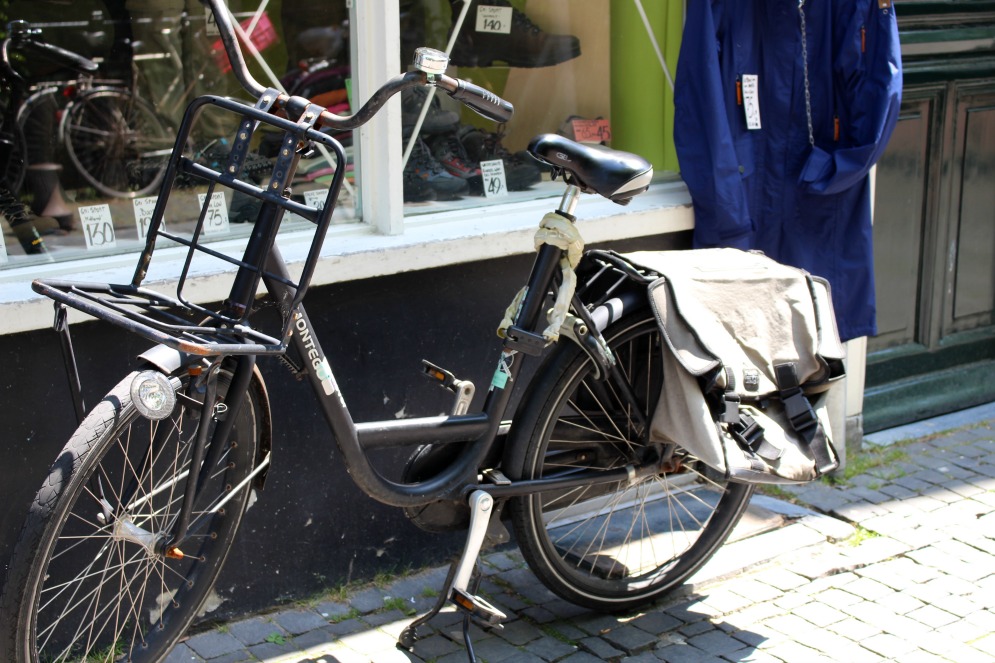
The phenomenon of two bags, draped over the carrier in the back of a bike, is called fietstassen in Dutch; bike bags. Commonly used to contain groceries or other larger volumes of items.
The Basket
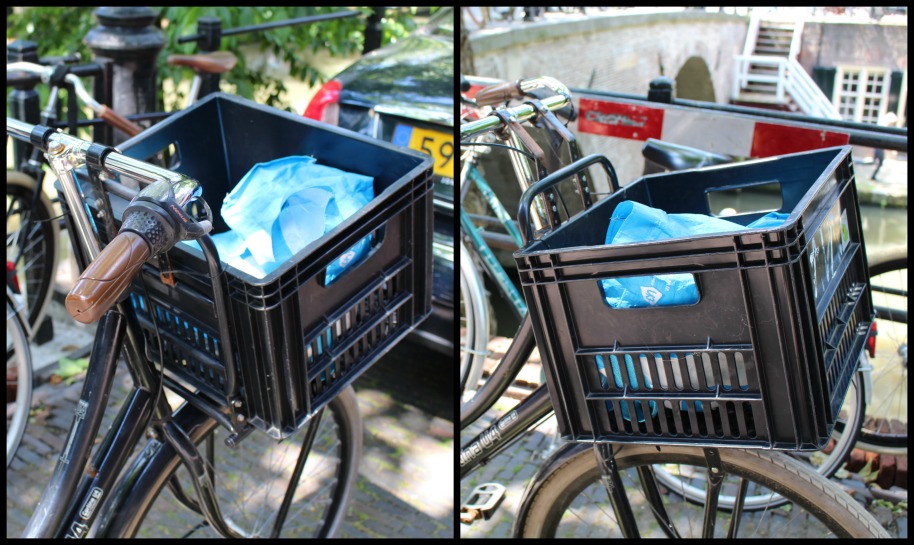
The basket, fastened onto a basket holder over the front wheel of the bike, is commonly used to hold handbags, groceries, or dogs.
Both the bike bags and the basket are considered a little bit anti-social in large cities, since they take up a lot of horizontal space, thus having the bike occupy a lot more room when parked in a public bike shed.
The “Whatever”
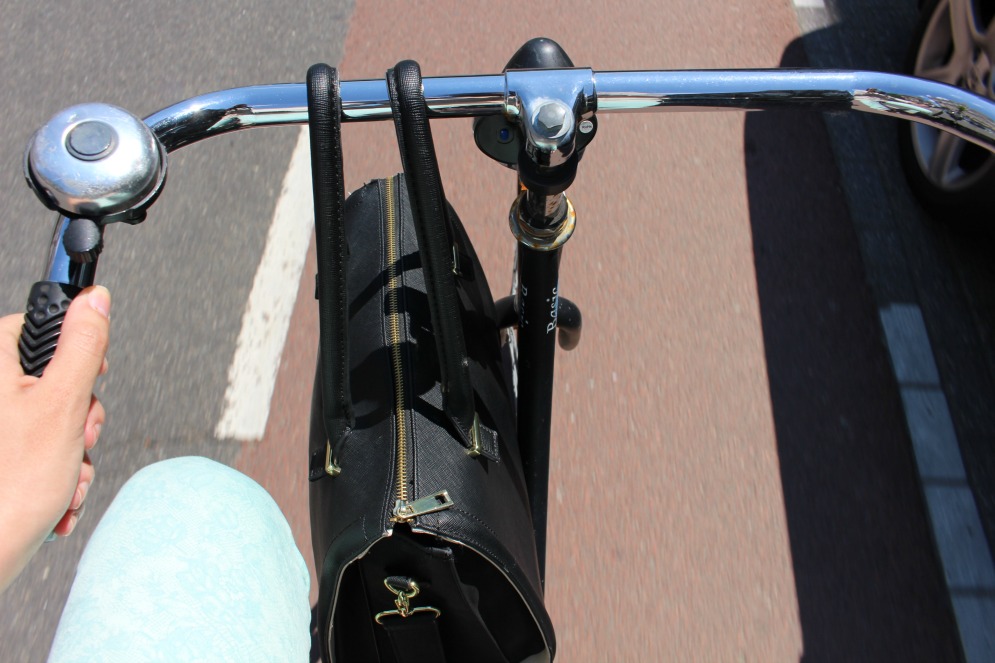
When neither of the options above are available, one needs to get creative. This is a picture of my own handbag, on my own bike, and this is how I generally carry my belongings. There are endless possibilities.
The Achterop
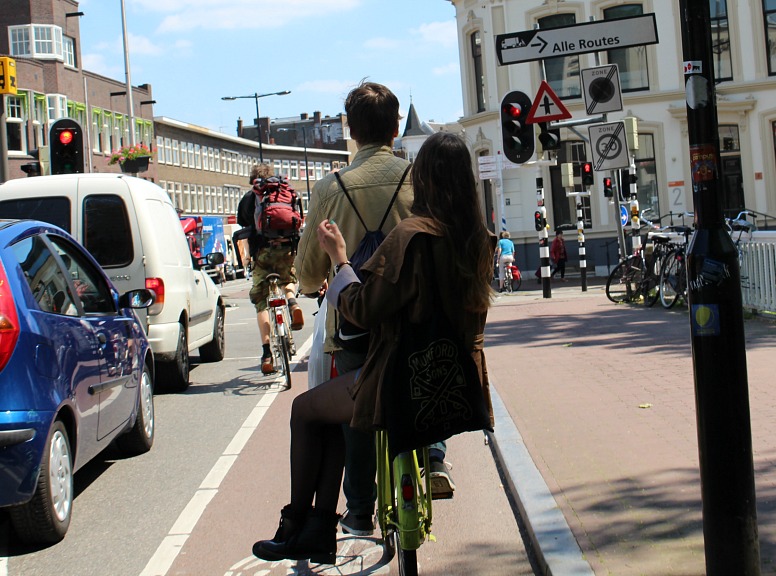
Achterop, meaning “on the back”, is this. One literally sits on the back of the bike. Various positions can be assumed, such as sideways, front-facing, or back-facing.
Achterop is most often utilized by young ladies, to make their boyfriends or buddies (male or female) do all the hard work for them. Do not underestimate achterop though, holding your legs up for extended periods of time is a proper workout for the abs.
You may have noticed a certain pattern in these pictures: the standard bike. Most people ride what’s known as omafiets, “granny bike”. It’s shaped with a very low cross-bar, originally developed to allow skirt-wearing ladies to ride a bicycle. This type of bike is the most convenient for urban use and is therefore the most popular type of bike, among both commuters and thieves.
The omafiets, although most common, is not the only type of bike on the scene, though.
The Foldable
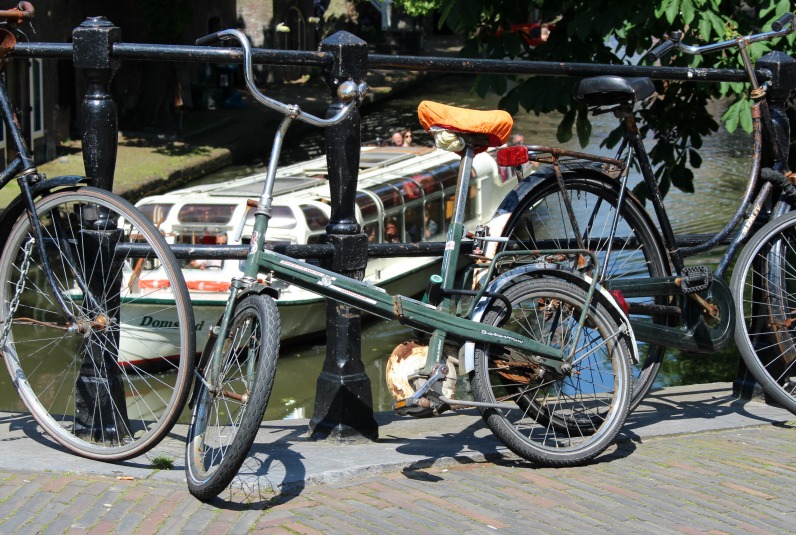
Yes, you read that right. This bike is actually foldable. It can be folded up into a nice compact object, which can be carried on public transport (mostly trains) without having to pay an extra bike-fee. Fascinating little thing.
The Odd One Out
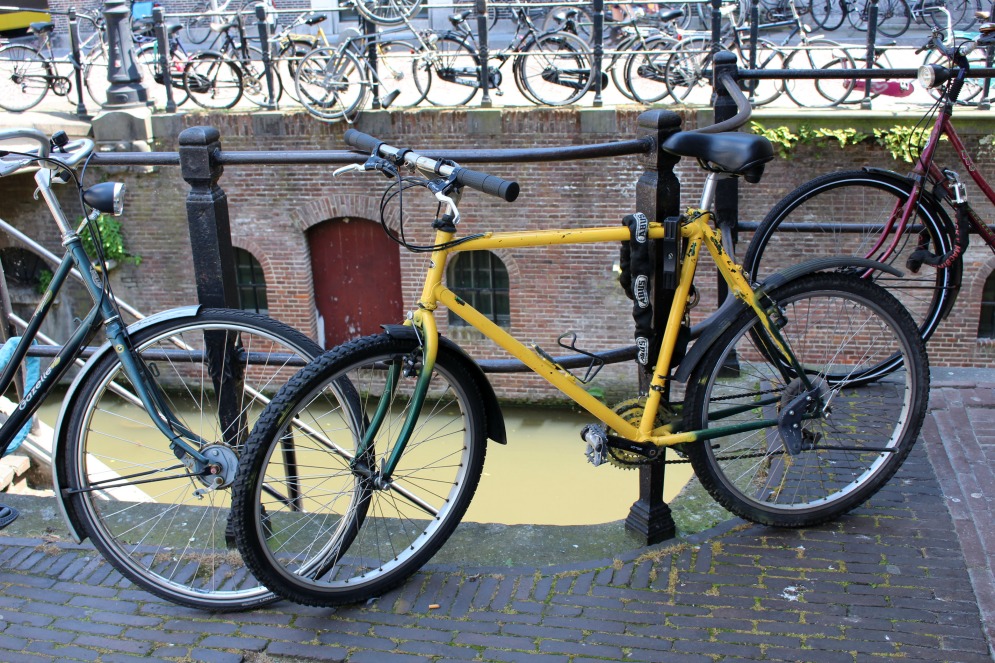
There’s always that one bike that’s just… odd. Is it a city bike? Is it a mountain bike? This most likely belongs to a foreign exchange student.
The “Shady”
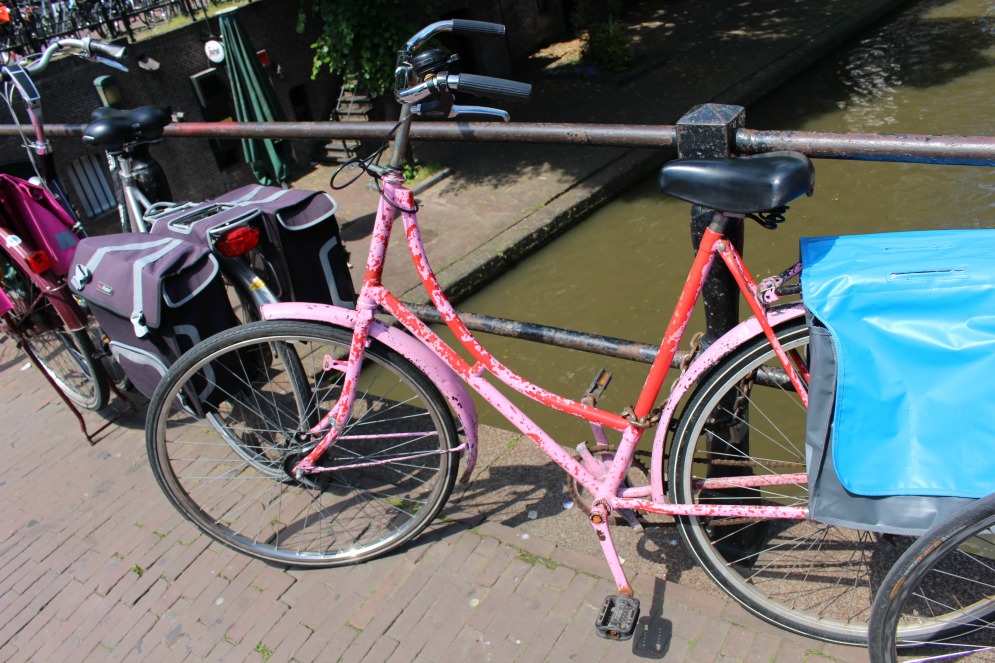
The dodgey paint job on this bike suggests it may have been stolen. Maybe more than once. Or maybe the owner just wanted a pink bike. Who knows…
The Decorated
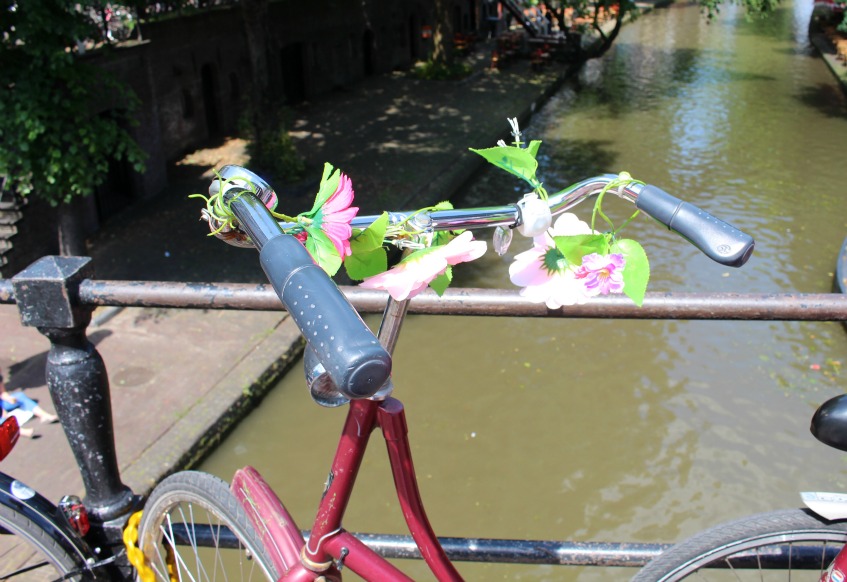
Both the handlebars and the basket are popular parts of the bike to decorate with fake flowers. This is mostly done by teenage girls and middle-aged women.
The Illegally Parked
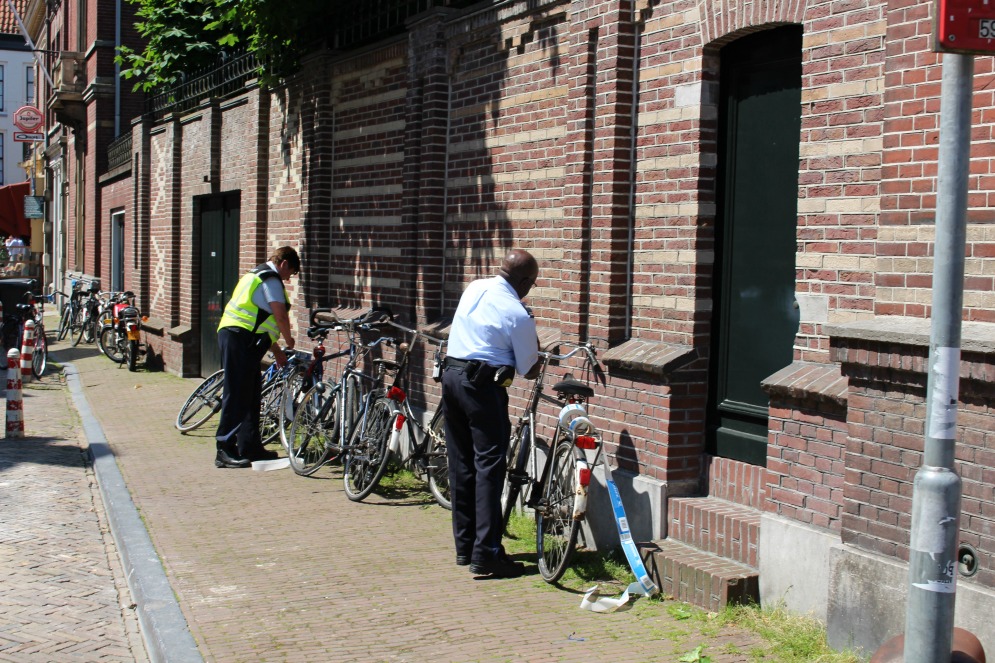
Even though it’s done all the time, parking your bike outside of bike sheds is actually illegal. Misparked bikes can be removed by authorities and moved to a storage, where one can pick up their bike after paying a fine.
The Public Transport
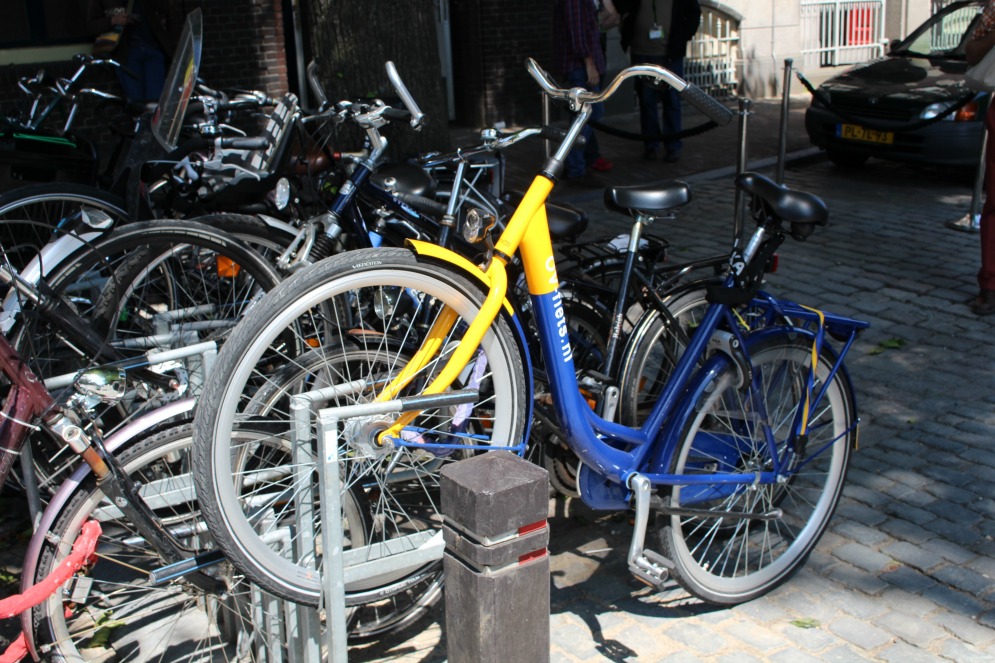
This, my dear friends, is a public transport bike. I’m not exactly sure how this works, but one can rent this bike for a certain period of time at certain locations, like train stations.
The Advertisement
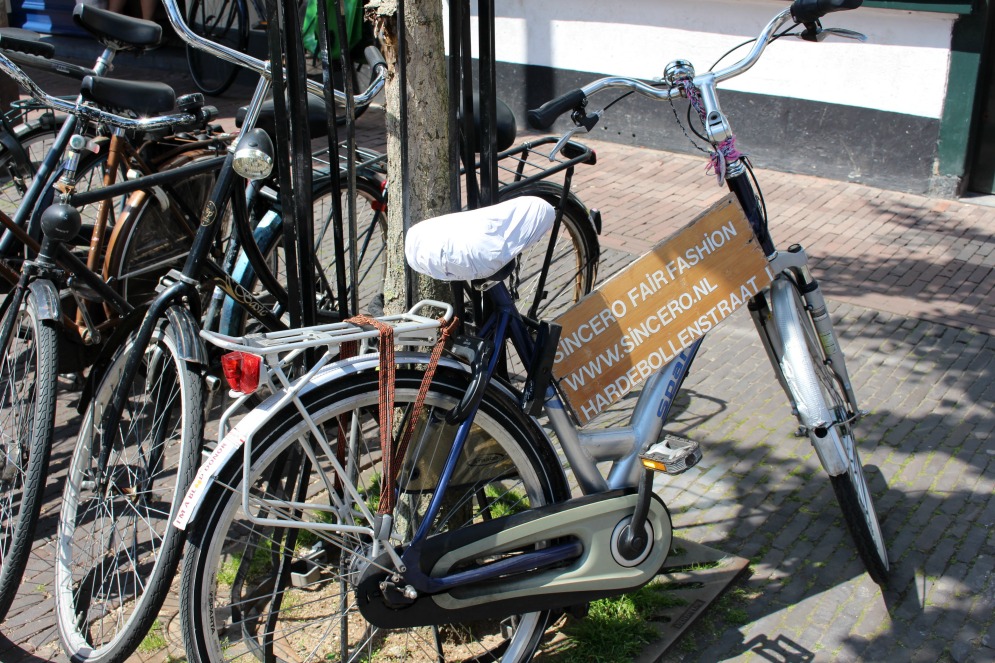
This one looks pretty amateur, but there are amazing professional advertisement bikes out there. It’s like sticking an ad on a car, just on a bike. Serves the same purpose.
We’re almost there. The last thing I want to show you is the situation that cyclists are in in the Netherlands.
The reason why we don’t wear helmets (and truly, nobody does) is that bikes, besides being extremey common, have all kinds of privileges in traffic.
The Bicycle Lane
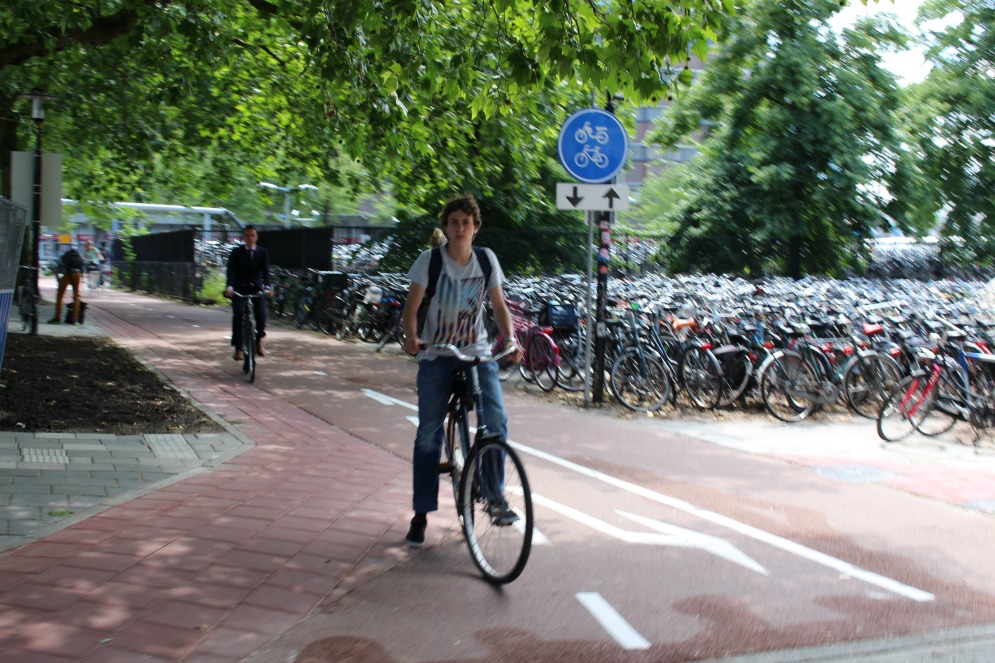
If you’ve ever been to the Netherlands, you will have noticed these red, skinny roads everywhere. They are special roads for bikes and most motorised vehicles (anything with more than two wheels or with a maximum speed above a certain limit) aren’t allowed on them. These bike roads can usually get you through the city much faster than the regular roads do.
The Lights
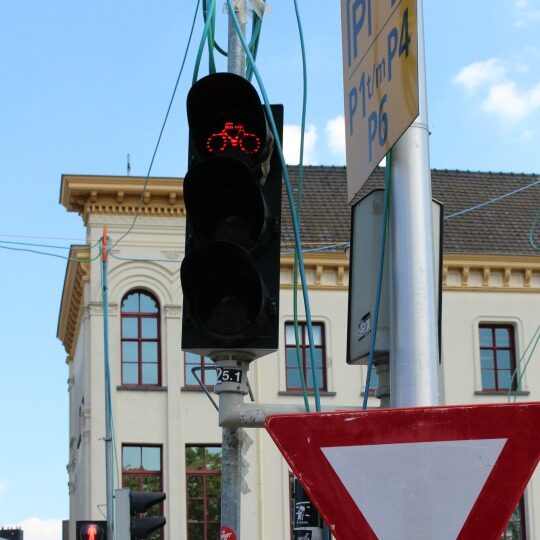
With special roads, come special traffic lights. They work just like regular ones so nothing too out of the ordinary there, but I do think they make for a funny sight if you’ve never seen one.
The Bike Shed
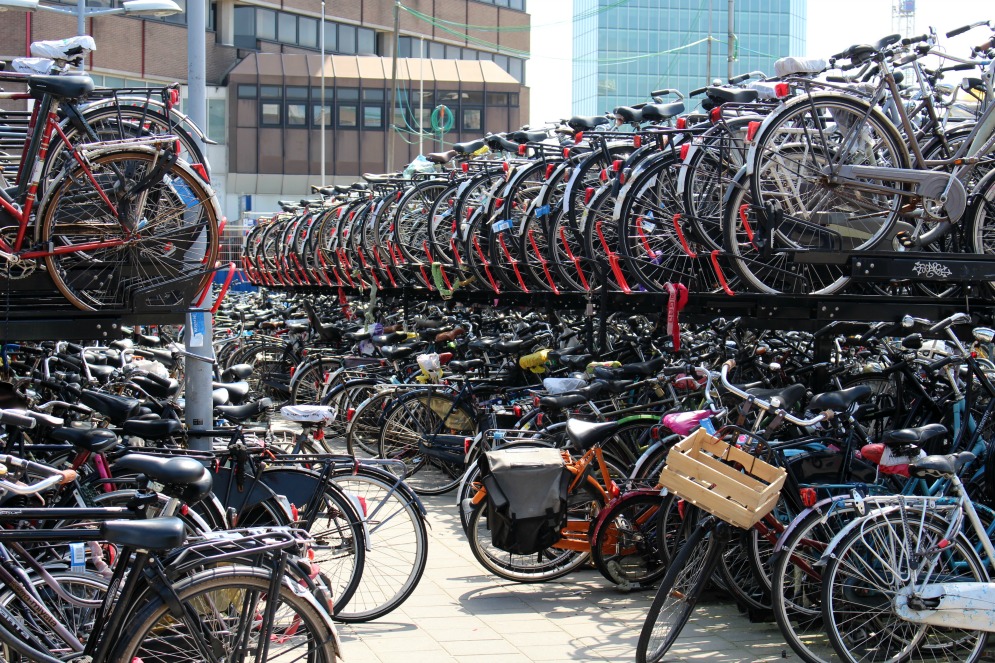
Massive bikesheds like this are usually found near train stations or schools. This photo is just a little cut-out, this thing is gigantic. And always full.
The Canal

This is what most canals look like in larger cities. The railing is basically made out of bicycles. Because there’s never enough space to park your bike where you want to, of course. Alternatively, one can park their bike inside the canal. It’s a permanent solution, and one that’s chosen surprisingly often.
Lastly, I wanted to show you a picture that perfectly captures the essence of this blogpost:
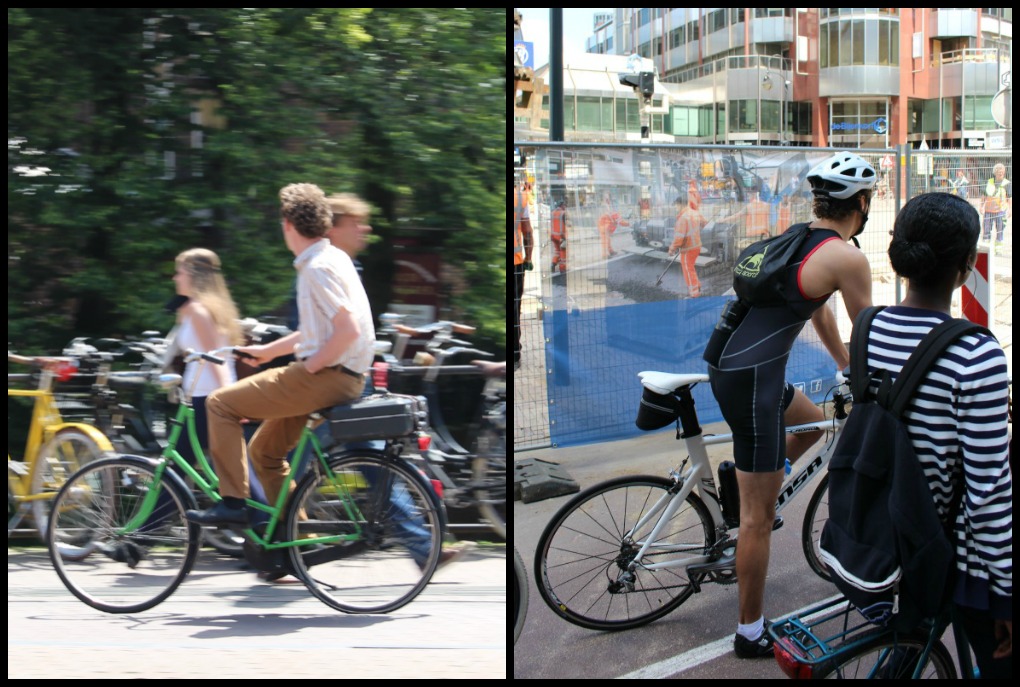
On the left, we see a businessman on an omafiets, obviously on his way to work with his briefcase achterop. This is what most Dutch cyclists look like.
On the right, we see a wielrenner (lit. “wheelrunner”), someone who does cycling as a sport. This is what I assume most non-Dutch people imagine cyclists look like. It couldn’t be further from the truth: these wielrenners are generally considered a nuisance in traffic since they often disregard the rules and tend to ride recklessly.
We don’t cycle because we want to, or because we find it relaxing, or for exercise. We cycle because it’s the most normal thing in the world for us to do. We cycle through rain, storms, snowfall, in the dark, to school, to work, to the store…
Cycling as a fun activity is done, but mostly by retired couples on the weekend. It involves different gear (electrical bikes and handlebar-mounted lunchbox/map holders) and is a distinctly separate activity. Just as you wouldn’t call your daily commute to work with your car a fun road trip :)
So that’s all that I’ve collected! I hope you found this entertaining and maybe learned a thing or two about how bikes work in the Netherlands.
What’s riding a bike like in your country?






In Norway we learn to bike when we are children. Students often are biking. Also, there are bike roads many places. In our small city you can hire a bike, started 2020 just by the park beside the new ice rink for kids. In our city we do biking as a sport and some years ago we began to make Ladies tour thanked to Emilie who bikes, where the best ladies in the world bike in a competition in August. The competitions Ladies tour are in other cities and villages in both South East Norway and Sweden as well. I have watched them live in the city centre or in tv. We also arrange Grenserittet in our city in the beginning if August. Also Birkebeineren rittet in Østerdalen is very popular for people who bike. We had no helmets in my childhood. Nowadays, we use helmets. I live in a city where to bike is more natural than to ski. I did both here when I was young. Car traffic has to stop when there are Ladies tour. You can bike in the centre as well to the railway station. Many bring the bike into the bus when they go home. We respect how and where we bike, and we follow the rules in the traffic. In Oslo people from time to time bike with their kids. In small cities they drive there kids with a car everywhere. Also, to bike in Rallarvegen in Norway is popular holiday in the mountain where you also can hire a bike in Hallingdal. Also there are several biking competitions, not elite only, in Norway during the summer. Norwegians like to bike in their holidays as well to Denmark and other countries.
Omg I loved this! It made me laugh a lot – I studied Dutch and visit the Netherlands as often as I can. I love how you can tell the bike probably belongs to an exchange student haha… However, I suck at cycling – I’m a bit scared of bikes – and because of how good everyone is in the Netherlands and how speedy, I’ve never dared rent a bike there in case I’m a nuisance. :p
OMG! This is just like Copenhagen! I didn’t realise that the Dutch and the Danes was exactly the same when it came to biking 😂 the only difference is that most of our biking roads are grey. Fun reading, thanks for sharing 😉
I was shocked at the amount of bikes in amsterdam. I’ve been twice and you really need to pay attention you dont get run over. The tram lines were confusing sometimes too. I was always looking around worried I’d get hit by a bike or tram. I’m my country the curb is quite high with bright white markers to seperate the roads from the side walks. So amsterdam city centre was confusing as a lot of the ground was level and the red bike paths were faded so it was hard to tell which parts were road/bike/footpath.
Central Amsterdam is the worst when it comes to traffic
I'm so jealous of those scenic cycle routes & safe lanes. Here in UK it cycle routes are mainly on the road right with the traffic-sometimes you have to impose yourself just to be given your space (I'm also a car driver so I can see how better routes would help all road users). I think the old sit-up-and-beg cycles are getting more popular again, though the mountain bike style (as mine) is common. More cycling vlogs please :)
I'm so jealous of your cycling lanes, I have to cycle on the road mostly, and since I live in an Old city with weird old pavements its not very comfortable :D
The Netherlands were like cycling heaven to me, but mainly because everything is so flat x). For me, cycling to Uni would mean 30 Minutes uphill. Yay.
You forgot the cart, as in the cart you can attach to your bike and is used to transport children and or dogs ;) Or is that more of a Flemish thing? :D Not sure but I see those around all the time
Here in Chile we have this trycicles that are used for cargo, i don't know if they are used in other contries, similar to the bakfiets, but with three wheels. At least where i live we have very little bycicle lanes and there are not continuous, so it's hard to use them as transportation.
Awesome post! Super informative and a fun read.
I think it would be cool to see a post about Dutch food and maybe your favorite sandwich toppings and spreads? The sandwich basket that you showed in your kitchen tour video has me intrigued :).
I'm actually terrified of riding a bike in the streets in the US. I would love if everyone could ride bikes, because not only would it help keep you fit, it would also help the environment. I already have my permit for driving in my state, but I'm so scared because you never know what could happen!! I'm scared of the cyclists who are on the streets because I don't want anyone to hit them.
I used to have a helmet when I was a kid! We would even do school trips on our bikes and a helmet was obligated on those trips ^^
Loepsie Yes it is. I was sitting at the back of my own bike once with my friend riding and a policeman stopped us to give us a lecture… ^^
I believe it's allowed, I've never heard it's not. Is it forbidden in Belgium?
I really love this post ! So interesting ! Infortunately, in France, cycling is still just sport, for most people. I would love to have more special road here, I would like to use my bike daily
Amazing! Very informative, Lucy! Great article!
I live in the Netherlands so nothing new to me but it is so much fun to look at our cycling culture in this way!
Basically the same in Stockholm, i would write sweden but I have no idea how it is, for example, in Göteborg or Malmö, and on the country side it's not the same, but in Stockholm more and more ride their bikes to work and it's quite scary to walk in the central parts of Stockholm where the bikes just pops up from nowhere. Most people don't wear helmets which I honestly think is really stupid, especially when they have their kids on one of those bike seats and the kid wears a helmet but not the parent, it's like do you want your kid to see you with a skull smashed in and dead? I just think it's such a waste of a life when people die in bike accidents and if they had worn a helmet they would've survived. Sorry for the rant
I grew up on the West coast of the US, lived a time in Chile and now live on the East coast of the US. No where I've lived uses bikes to nearly the same degree as you do in the Netherlands. We are filled with, what you called, the "wielrenner". They are reckless and dangerous here as well to, both, cars and pedestrians alike. I wish the US would adopt a love for cycling as your country has. We could definitely do with less cars here.
Hahaha, I just love this article! :) Here in Belgium, the "cycling culture" is more or less the same, only that we don't have traffic lights for cyclists. By the way, is sitting "achterop" allowed in the Netherlands?
Great post!
I grew up in a town right at the Dutch-German border and it was practically the same until the public transportation system was vastly expanded, now I would think it is similar to a degree, maybe 50:50. Especially college/uni students use mainly bikes. Here (rural US) there are few bike routes and almost only downtown. Outside town where I live, cycling on the crooked/windy roads through the woods while competing with cars can be hazardous and is almost exclusively done by those reckless "wielrenner" sports cyclists (yeah, we have them here too).
Cycling is definitely not feasible as means of transportation here.
Hehe thanks! I'm loving all your little Dutch posts! I'm visiting Venlo and Zwolle in August, to attend a wedding, and finding out a little more here and there always helps :) This post has made me want to rent a bike and go for a ride with the friends I'm staying with. You couldn't do a post about your weddings could you? As I've heard they are a bit different to British ones!
Wow, great post! I love it!